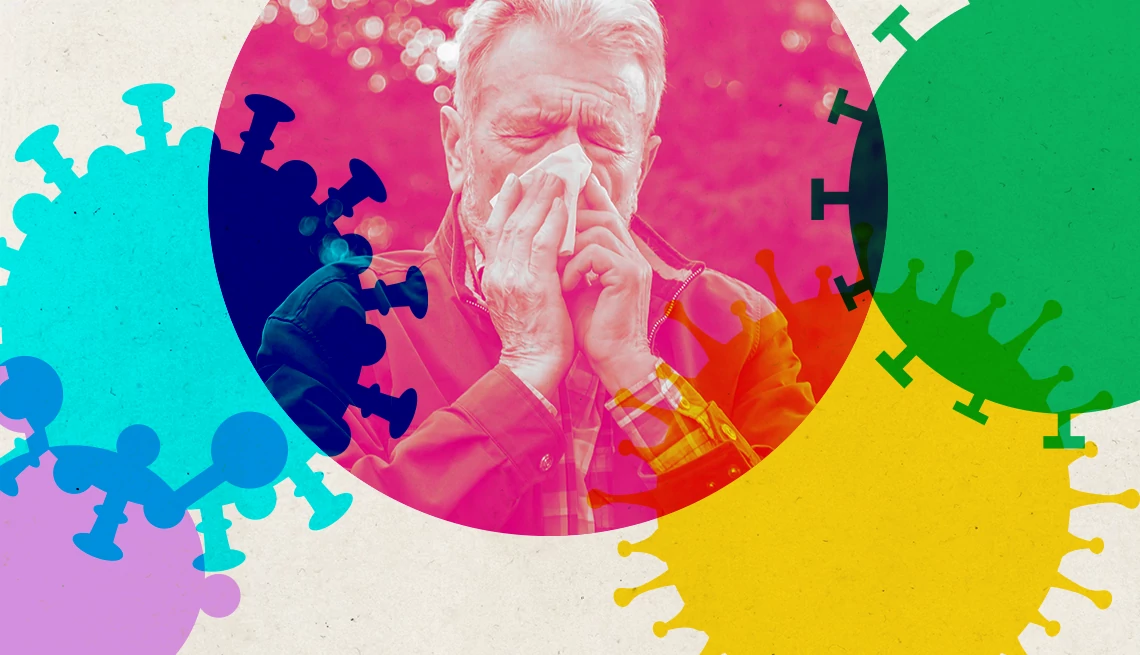AARP Hearing Center


A trio of respiratory illnesses — flu, COVID-19 and RSV — is sweeping the U.S. and leaving a trail of coughing and aching victims in its wake. But this winter, there’s a fourth bug that’s also bringing misery to the masses: Outbreaks of norovirus, a gastrointestinal affliction, are surging too, data from the Centers for Disease Control and Prevention (CDC) shows. The convergence of all four has spawned the nickname the “quad-emic.”
An uptick in any of these viral illnesses is not unexpected this time of year, health experts say. Cases of flu, COVID and RSV (short for respiratory syncytial virus) tend to start climbing in the fall and peak in the winter months. Currently, emergency room visits for flu and RSV are high and continue to increase, the latest CDC data shows.
Norovirus cases also tend to creep up in the cold-weather months, even though you can catch the nasty stomach bug any time of year, says William Schaffner, M.D., professor of preventive medicine and infectious diseases at Vanderbilt University School of Medicine. However this year, “we appear to be having, across the country, a more substantial winter increase of norovirus,” Schaffner says. According to the CDC, reported norovirus outbreaks for the 2024-2025 season are the highest they have been in 12 years.
Edward Liu, M.D., chief of infectious diseases at Hackensack Meridian Jersey Shore University Medical Center in New Jersey, says we don’t have a clear understanding as to why norovirus cases are especially high this year. It could be that more people are clustering together this winter, he says. (Norovirus is highly contagious and can spread quickly and easily from person to person.)
A new strain of the virus could also be to blame, since “newer strains generally circulate more widely until things tamp down,” Schaffner adds.
Quad-emic is a threat to older adults
Age-related changes that impact the immune system — plus underlying chronic health issues that become more common with age — put older adults at higher risk for serious complications from respiratory illnesses such as COVID, flu and RSV, the CDC says. Warning signs of severe illness with these infections can include trouble breathing, pain or pressure in the chest, and dizziness or confusion, among others.
Similarly, older adults are among those at higher risk for complications from a norovirus infection. The virus causes around 900 deaths in the U.S. each year, and most are among adults aged 65 and older, the CDC says.
The concern with norovirus, which brings on vomiting and diarrhea, is dehydration, Schaffner says. “Deaths associated with norovirus usually are a consequence of dehydration and also loss of control of chronic underlying illnesses,” he says.
Older adults are more vulnerable to dehydration, research shows, since the amount of water in our bodies decreases with age. Decreased kidney function can also affect fluid levels in older bodies, the Cleveland Clinic says. Signs of dehydration can include decreased urination, dry mouth and throat, fatigue, and feeling dizzy when standing up, according to the CDC.
What’s more, weakness caused by days of nausea and vomiting with a norovirus infection can put older adults at higher risk for falls, Liu says. And falls are the leading cause of injury among adults 65-plus.


































































More From AARP
FDA Approves At-Home Flu Vaccine
Why older adults will benefit even though it’s only for people under 50A Combo COVID-Flu Vaccine Could Be Here Soon
A single shot could boost immune response and vaccination ratesWhat It’s Like to Catch COVID Over and Over
He’s had four bouts so far, and he says it has changed him